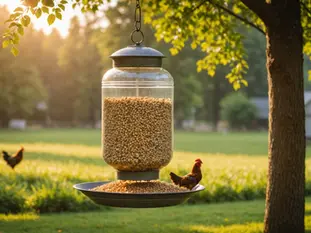Dani's Hen House

Raising chicks can be a fulfilling experience, but it comes with a set of challenges that every farmer must tackle. One of the most urgent issues is heat stress. As summer temperatures rise, the health and safety of young chicks are at risk. This blog post examines the effects of heat stress, how to recognize its symptoms, and practical measures you can take to prevent it from endangering your flock.
Understanding Heat Stress in Chicks
Heat stress happens when chicks cannot regulate their body temperature due to excessively high environmental conditions. Unlike mature birds, chicks have limited ways to cool themselves, making them particularly vulnerable to extreme heat.
When facing high temperatures, a chick's internal body temperature can spike dangerously. Statistics reveal that temperatures above 90°F can lead to a decline in chick survival rates by nearly 25% in the critical first weeks of life. Recognizing this issue is essential for maximizing the health of your flock.
Signs and Symptoms of Heat Stress
Timely detection of heat stress in chicks is vital for effective intervention. Here are several symptoms to watch for:
Increased Breathing Rate: Chicks will often breathe faster in a bid to cool down, a clear sign of discomfort.
Panting: You may observe that stressed chicks begin to pant, which is unusual behavior for them.
Weakness or Lethargy: Affected chicks may look weak or unresponsive, often isolating themselves from the group.
Drooping Wings: As they struggle to cope with the heat, their wings may droop, indicating a drop in energy levels.
Decreased Food and Water Intake: Chicks under heat stress typically eat and drink less, which can lead to dehydration and further health concerns.
Spotting these signs early can significantly improve the chances of saving affected chicks before the situation worsens.

Risk Factors to Consider
Certain factors can elevate the risk of heat stress in your chicks:
Age: Younger chicks are especially susceptible due to their immature temperature regulation systems.
Flock Density: Overcrowding intensifies heat stress, as limited movement space makes it hard for chicks to cool down.
Environmental Conditions: High humidity paired with high temperatures can triple the likelihood of heat stress. For example, a temperature of 85°F with 70% humidity can feel like 95°F to the chicks.
Ventilation: Poor airflow can trap heat, turning a manageable temperature into a dangerous situation quickly. Maintaining a well-ventilated structure can reduce internal temperatures by up to 15°F.
Being aware of these factors enables proactive management, ensuring that your flock remains healthy and safe.
Preventing Heat Stress in Chicks
You can effectively prevent heat stress through good management practices. Here are some strategies that can make a difference:
Optimal Housing: Keep your chicks in a well-ventilated space that promotes good air circulation. Using fans and creating shaded areas will significantly lower heat buildup.
Hydration: Fresh, cool water should always be available. Regularly change the water and consider adding ice cubes on particularly hot days to keep it cool.
Feeding Adjustments: Alter feeding schedules to the cool hours of the day, ideally in the early morning or late evening. This simple change can reduce heat stress and improve digestion.
Monitor Conditions: Regularly check the temperature and humidity levels in the raising area. Keeping records can assist you in identifying patterns and addressing concerns before they escalate.
Heat Stress Equipment: Using wet bulb temperature monitors provides critical insights into whether conditions are becoming perilous for your chicks.
Proactive measures are essential for the well-being of your chicks.
Treatment of Heat Stress
If you notice signs of heat stress, take swift action to mitigate the problem:
Lower Ambient Temperature: Quickly reduce the temperature by providing shade or using fans to circulate air.
Hydration: Ensure that chicks can access cool, fresh water at all times. Consider adding electrolytes to their water for faster recovery.
Reduce Density: If feasible, spread chicks out to decrease overcrowding. This allows for better air circulation and cooler resting spots.
Observation: Continuously monitor the flock and offer extra care to weak chicks. This supportive action can prevent further health complications.
Taking quick steps when recognizing heat stress can be lifesaving, emphasizing the importance of vigilance and prompt action.

Final Thoughts on Heat Stress Management
Heat stress is a serious concern for those raising chicks. Understanding its causes, symptoms, and preventive strategies is crucial for maintaining your flock's health and longevity.
With attentive care and management, you can decrease the risks associated with high temperatures and help your chicks thrive. Always remember that being proactive can be the difference between life and death. As caretakers, it is our responsibility to monitor environmental conditions closely and ensure they remain favorable for our young birds.
By remaining alert and implementing effective measures, you can create a safe, healthy environment that enables your chicks to flourish. Keep this in mind: a healthy chick is a thriving chick!





